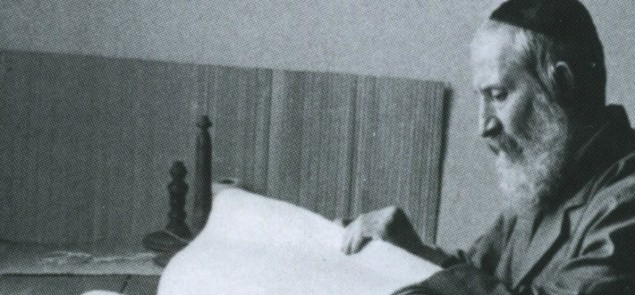One Sofer, One “Coincidence” and 1,500 Torah Scrolls
Some months ago, inside the entrance of a small museum in a non-Orthodox synagogue in the center of London, I saw an apparently incongruous sight—a display case featuring several unrolled Torah scrolls and a large black-and-white photograph of a Chassidic Jew seated at a wooden drafting table.
I’ve seen such artifacts in other non-Orthodox congregations. But those in Westminster Synagogue in London, especially the photo, are no nostalgic paean to a distant, unfamiliar part of Orthodox life. Rather, they’re part of Westminster Synagogue’s recent history.
“This was Mr. Brand,” a guide told me, leading me through the museum.
David Eliahu Brand, a Satmar chassid who was born in Israel and died there in early 2015, was Westminster Synagogue’s in-house sofer. For nearly three decades he made some 1,000 posul sifrei Torah rescued from the Holocaust kosher again, fit for use in congregations around the world. If a shul outside of the countries occupied by Nazi Germany has a “Holocaust Torah” in its ark today, the scroll probably came via London, and it probably was because of the tikkun work of Mr. Brand.
Even more unlikely than a Chareidi Jew serving long-term at a Reform temple is how he came there in the first place.
Through the generosity of Ralph Yablon, a philanthropic attorney and Westminster Synagogue member, in 1964 the congregation took possession from the Czech government of 1,564 ownerless sifrei Torah that had been collected and catalogued under Nazi auspices in Prague during World War II. The synagogue arranged for a team of local Orthodox rabbis to inspect the scrolls upon arrival to determine which ones, after decades of moldy storage in a Prague synagogue-turned-warehouse, were salvageable. Westminster Synagogue found itself with shelves of sifrei Torah, and a problem. Where would it find a competent sofer?
According to a story that has assumed legendary status, Mr. Brand, a second-generation sofer in London looking for work, was walking near Hyde Park and noticed the word “synagogue” on a building. He knocked on the door. Ruth Shaffer, a Warsaw native who was coordinating Westminster Synagogue’s Torah restoration project, serendipitously answered the door.
Mr. Brand, speaking in Yiddish, identified himself. Es gibt Torot? “Do you have any Torahs?”—scrolls in need of repair?
“Yes, we have 1,564,” Shaffer, who also spoke Yiddish, answered. “Do come in.” Mr. Brand was introduced to Rabbi Dr. Harold Reinhart, the congregation’s spiritual leader. “It was not long before it became clear that the association of Mr. Brand with Westminster Synagogue was ‘a marriage made in heaven,’” Phillippa Bernard writes in Out of the Midst of the Fire, a 2005 book that describes the Torahs’ paths from their original homes to Prague, London, and then to a score of venues around the world.
For the next twenty-seven years, Mr. Brand worked in a third-floor room of the synagogue. He brought his family to London to a rented apartment a few miles away, davened in an Orthodox shul and immersed himself in a mikvah each morning before heading by Tube or bus to his holy work. He brought his own bag of kosher food and took a small elevator directly to his window-lit working space.
During those years, Mr. Brand repaired about 1,000 scrolls. They were sent, at no charge, on permanent loan to a variety of institutions, mostly small congregations that could not afford to buy their own sefer Torah and appreciated the symbolism of an object with Holocaust-survivor provenance. Most recipients are in the United States.
“There was a lot of work,” said Rabbi Ariel Friedlander, my tour guide, now in charge of the Synagogue’s Memorial Scrolls Trust (memorialscrollstrust.org).
When his workload lessened, Mr. Brand retired in 1992, leaving London for Israel. He died at eighty-seven, but his legacy—and his photograph—remains at Westminster Synagogue.
While many non-Orthodox congregations engage an Orthodox sofer on an ad hoc basis to repair or write a sefer Torah, Mr. Brand’s ongoing relationship with such a synagogue was, as far as is known, unique.
He never commented to his family about his unusual work setting, his daughter Pesi Bloy told me. “There are a lot of sifrei Torah,” he would explain. “I have to repair them.”
“He could correctly be described as an ambassador for Chassidim,” author Bernard said. “He was a delightful, gentle man to work with, never expressing any opinion about our form of Judaism, though he would never partake of any form of food or drink with us. He had a great sense of humor, and was tolerant of everyone he encountered. He loved to discuss his work with anyone interested, particularly children. His arrival was quite fortuitous.”
“He lucked out,” Rabbi Friedlander said, using an “American expression” for my sake.
“And so did we.”
Steve Lipman is a frequent contributor to Jewish Action.

